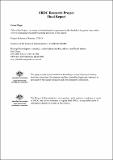| Author | Danzi, E |
| Date Accessioned | 2013-11-05 |
| Date Available | 2013-11-05 |
| Issued | 2007 |
| Identifier | http://hdl.handle.net/11079/12868 |
| Abstract | In the late 1980’s the Burdekin dam commenced operation and resulted in a large area of land being
cleared and converted to irrigation. This influx of water has caused the groundwater level to rise
alarmingly over the past 20 years from its previous level typically 10 to 15 meters below the surface
to around 0.5m in some places in 2009. This is an alarming increase and if not rectified and
reversed quickly will lead to significant crop losses and is likely to render some land unviable for
farming in the next 5 years. |
| Abstract | The original objective of the project was to review of institutional arrangements in the Burdekin
Irrigation Area with a view to managing sustainable farming practices in the region. These
objectives have been achieved in the project and the project has gone far beyond the original
objective of the project. We are now almost 6 months into implementation which was considered
beyond the realistic scope of the original project. |
| Abstract | A consultant undertook an analysis of the current state of the BRIA groundwater system and made
recommendations on what needs to be done in the BRIA to correct the groundwater problem. The
consultant also made broad estimates of a range of possible leakages that may be occurring from
irrigation and leaking channels since there was inadequate data to be more accurate. |
| Abstract | If the trend in groundwater levels continues to rise over the 10 years it is reasonable to expect that
large areas of the BRIA will taken permanently out of cane production. Although it is hard to
estimate how much area could be affected it would be likely that at least 10 per cent of the BRIA
would be at risk which is around 4000ha. At 115t/ha average production this amounts to almost
0.5mt of cane could be lost out of the industry if the groundwater problem is not fixed. At current
sugar prices, this would be a loss of aver $30m in sugar production alone. |
| Abstract | The next phase of the project has already commenced and is about implementation of the plan
developed in this project. There is a significant need for further funds for this to be successful.
CANEGROWERS in currently investing in employing a consultant to develop an automated flood
irrigation system for the BRIA as outlined previously in this report. This is due for completion in
June 2010 and if it is successful we will be able to roll this out commercially to growers in the
BRIA and encourage uptake. |
| Language | en |
| Part of Series | Internal Report; 2007 CG018 |
| Subject | Burdekin |
| Subject | Groundwater management |
| Subject | Irrigation management |
| Subject | Leaking channels |
| Subject | Groundwater levels |
| Subject | Flood irrigation system |
| Subject | BRIA groundwater plan |
| Subject | SIRMOD modelling |
| Subject | Farming systems |
| Subject | Production management |
| Title | A review of institutional arrangements in the Burdekin irrigation area with a view to managing sustainable farming practices in the region : SRDC Final report CG018 |

